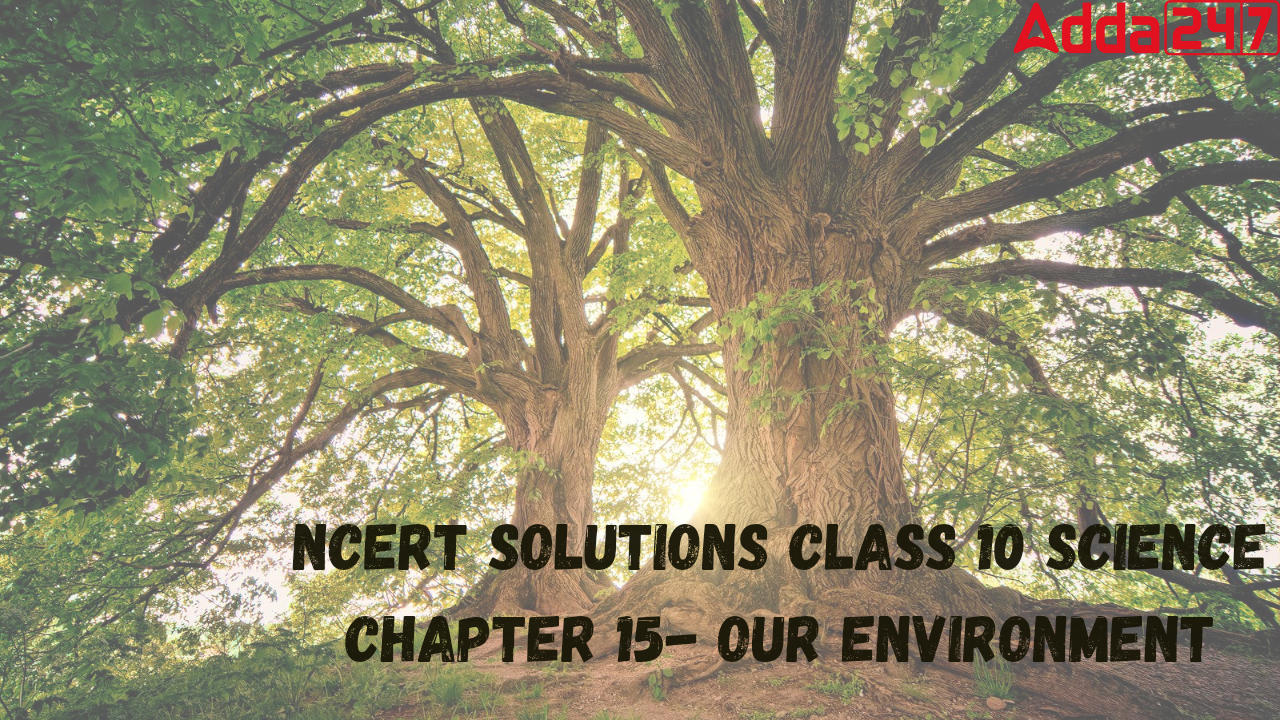Table of Contents
Students benefit from the Class 10 Science Chapter 15 (our environment) in fully grasping the concepts of the natural environment. Experts in their fields have created all of the NCERT solutions, adhering to the most recent CBSE curriculum. Students will be able to better understand the concepts and ideas presented in the CBSE Class 10 Science chapter 15 with the aid of the questions and the thorough solutions provided here. Students can use this article to find NCERT solutions for the science chapter 15 notes for class 10 too. Students can also find additional questions and answers related to our surroundings in class 10.
NCERT Solutions Class 10 Science Chapter 15 (Our Environment) Notes
NCERT Solutions Class 10 is the best resource for obtaining a good score in the class 10 board Examination. Here are Adda247 Expert faculty team prepared NCERT Solutions Class 10 Science Chapter 15 Our Environment along with in-text questions and exercises of that chapter for a better grasp of the topics. Chapter 15 of Science for Class 10 NCERT Solutions solved Students in our environment will not only do well on board exams, but they will also succeed in competitive exams like JEE Main, NEET, JEE Advanced, and so on. So that students can pass their board exams with good scores. Keep learning with Adda247.
NCERT Solutions Class 10 Science Chapter 15 Our Environment PDF
Our subject experts at Adda 247 have given a detailed explanation and solutions of important questions related to this chapter. These solutions is in line with the latest CBSE curriculum. Click here to download NCERT Solutions Class 10 Science Chapter 15 Our Environment in PDF format
NCERT Solutions Class 10 Science Chapter 15 Our Environment
NCERT Solutions Class 10 Science Chapter 15- Our Environment Quick Revision
Watch the below-given video explanation of Our Environment
NCERT Solutions Class 10 Science Chapter 15 Our Environment Important Questions and Answers
In-text Questions Page: 260
Question 1. What are the trophic levels? Give an example of a food chain and state the different trophic levels in it.
Trophic levels are the levels In the food chain. The transfer of food or energy takes place at various levels trophic levels in the food chain.
Example:
Grass – 1st Trophic level
Grasshopper – 2nd Trophic level
Frog – 3rd Trophic level
Snake – 4th Trophic level

In the above food chain, Grass serves as both the producer and the primary consumer. The grasshopper is the secondary consumer. The frog is the third consumer. and Snake is the tertiary consumer in the food web.
Question 2. What is the role of decomposers in the ecosystem?
Decomposers play many vital roles in the ecosystem
- They purify the environment by degrading dead animals and plants.
- They assist in recycling various nutrients and components that make up dead plants and animals back into the environment which will use by producers like crop plants to produce food.
- By decomposing dead organisms, Decomposers create room in the biosphere for new organisms.
In-text Questions Page: 262
Question 1. Why are some substances biodegradable and some non-biodegradable?
Due to the specialized roles that microbes like bacteria and decomposers perform, some substances are biodegradable and some are not. Because some chemicals can be broken down by microbes while others cannot, substances are categorized as biodegradable and non-biodegradable.
Biodegradable substances are those that can be easily broken down by microbes like wood, and paper. On the other hand, non-biodegradable which are not breakdown by microbes such as plastic.
Question 2. Give any two ways in which biodegradable substances would affect the environment.
Two ways in which biodegradable substances would affect the environment are
- Biodegradable substances are easily decomposed in water and soil, which increases soil fertilization.
- The help of decomposers allows Biodegradable substances to complete the geochemical cycle.
Question 3. Give any two ways in which non-biodegradable substances would affect
the environment.
Two ways in which Non-biodegradable substances would affect the environment are
- The biodegradable substance causes various types of environmental pollution.
- They contaminate soil and water resources because microorganisms cannot break them down. it reduces soil fertility.
In-text Questions Page: 264
Question 1. What is ozone and how does it affect any ecosystem?
Ozone or O3 is an isotope of O2 that is made of three atoms of Oxygen. The primary function of the ozone layer in the atmosphere is to shield the surface of the planet from the sun’s harmful UV rays. These rays can cause skin cancer and are dangerous to organisms.
Question 2. How can you help in reducing the problem of waste disposal? Give any two methods.
The following are some methods to solve the issue of waste disposal:
- By distinguishing between biodegradable and non-biodegradable materials. We can use Non-biodegradable for Compost preparation.
- Reducing, reusing, and recycling solve the issue of waste disposal substances, can solve the issue of waste disposal.
- Use more non-biodegradable products instead of biodegradable products. For example, We can use jute bags instead of plastics.
NCERT Solutions Class 10 Science Chapter 15 Our Environment Exercises
1. Which of the following groups contain only biodegradable items?
(a) Grass, flowers, and leather
(b) Grass, wood, and plastic
(c) Fruit peels, cake, and lime-juice
(d) Cake, wood, and grass
Answer: a) Grass, flowers, and leather
c) Fruit peels, cake, and lime juice
d) Cake, wood, and grass
2. Which of the following constitutes a food chain?
(a) Grass, wheat, and mango
(b) Grass, goat, and human
(c) Goat, cow, and elephant
(d) Grass, fish, and goat
Answer: (b) Grass, goat, and human constitute a food chain.
3. Which of the following are environment-friendly practices?
(a) Carrying cloth bags to put purchases in while shopping
(b) Switching off unnecessary lights and fans
(c) Walking to school instead of getting your mother to drop you on her scooter
(d) All of the above
Answer: (d) All of the above are environment-friendly practices
4. What will happen if we kill all the organisms at one trophic level?
Answer: If we kill all the organisms at one trophic level, the food chain will collapse and the ecosystem will become unstable. Higher trophic level animals in the food chain, can’t get enough food. Low trophic level animals are drastically increasing. As a result, the ecosystem becomes unstable.
5. Will the impact of removing all the organisms in a trophic level be different for
different trophic levels? Can the organisms of any trophic level be removed without
causing any damage to the ecosystem?
Yes. Removing all the organisms at a trophic level will be impacted differently for different trophic levels. Every organism is important at a trophic level. if producers were eliminated, herbivores would either be unable to survive or relocate, causing the ecosystem to collapse. Carnivores wouldn’t have access to food if herbivores were eliminated, allowing producers to expand uncontrolled. If carnivores are removed, herbivore populations will rise to alarming proportions and the producers might be wiped out. In the absence of decomposers, dead animals would gather and pollute the ecosystem.
As a result, the disruption of the food chain caused by the removal of organisms at any level would disrupt the ecosystem.
6. What is biological magnification? Will the levels of this magnification be different at
different levels of the ecosystem?
Biological magnification is the term used to describe the rise of toxic chemical concentrations, such as pesticides, within the bodies of living things at every level of the biological process.
Yes. Every level of the ecosystem is impacted by the increase in magnification at the subsequent trophic levels, and the concentration may differ from the initial level. This may have an impact on the organic processes of the organisms, such as growth and reproduction.
7. What are the problems caused by the non-biodegradable wastes that we generate?
The problems caused by the non-biodegradable wastes that we generate are –
- The primary causes of pollution in the land, air, soil, and water are non-biodegradable wastes.
- Non-biodegradable substances cannot be broken down by microbes, therefore dumping becomes more problematic as the amount increases.
- The pH level of the soil becomes unfavorable for vegetation as a result of pesticide wastes, which reduce soil fertility.
- If not treated, The non-biodegradable wastes will significantly harm the animals, birds, plants, and people in our environment.
8. If all the waste we generate is biodegradable, will this have no impact on the environment?
Microorganisms break down biodegradable waste into simpler materials that can be used to produce compost, The consequences of an excess of biodegradable wastes, however, are as follows:
- Due to their slow breakdown, biodegradable wastes emit a foul smell that can be toxic to humans if they breathe it in.
- The composition of biodegradable wastes emits toxic greenhouse gases. These gases have the potential to build up in the atmosphere and cause warming.
- The dumping sites of biodegradable wastes may serve as a breeding ground for dangerous organisms that can harm not only plants and animals but also humans.
9. Why is damage to the ozone layer a cause for concern? What steps are being taken to limit this damage?
Our atmosphere is shielded from dangerous rays by the ozone layer. All living and nonliving things are significantly protected from the Sun’s harmful UV Rays. UV Rays cause skin cancer and many other diseases. The following actions are being made to reduce the damage of the ozone layer.
- We have to minimize the use of fossil fuel vehicles.
- All manufacturing companies must now create CFC-free refrigerators all across the world
- We must use renewable energies instead of Fossil fuels.



 CUET PG Result 2025 Soon @exams.nta.ac.i...
CUET PG Result 2025 Soon @exams.nta.ac.i...
 NEET Admit Card 2025 Release Date, How t...
NEET Admit Card 2025 Release Date, How t...
 CUET UG 2025 Vs CUET UG 2024, Check Majo...
CUET UG 2025 Vs CUET UG 2024, Check Majo...










